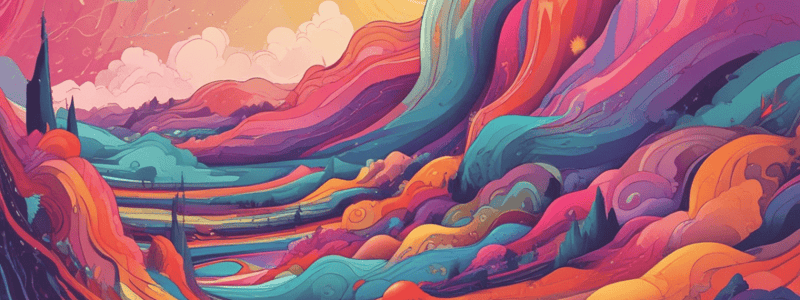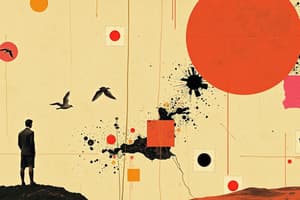Podcast
Questions and Answers
What is the fundamental element of visual art that is a mark made by a moving point?
What is the fundamental element of visual art that is a mark made by a moving point?
- Line (correct)
- Shape
- Value
- Form
What is the result of lines intersecting or enclosing an area?
What is the result of lines intersecting or enclosing an area?
- Value
- Shape (correct)
- Form
- Line
What is the three-dimensional representation of an object in space?
What is the three-dimensional representation of an object in space?
- Line
- Shape
- Value
- Form (correct)
What is the element of visual art that has the power to evoke emotions and express mood?
What is the element of visual art that has the power to evoke emotions and express mood?
What is the term used to describe the lightness or darkness of a color or tone?
What is the term used to describe the lightness or darkness of a color or tone?
What are the three categories of colors?
What are the three categories of colors?
What is the term used to describe the feeling or atmosphere conveyed by a color?
What is the term used to describe the feeling or atmosphere conveyed by a color?
What is the result of the manipulation of light and shadow within a composition?
What is the result of the manipulation of light and shadow within a composition?
What is the term used to describe the surface quality of an object or a representation of it?
What is the term used to describe the surface quality of an object or a representation of it?
Which type of space refers to the empty areas around objects in a composition?
Which type of space refers to the empty areas around objects in a composition?
What is the arrangement and organization of visual elements within a piece of art called?
What is the arrangement and organization of visual elements within a piece of art called?
Which colors cannot be created by mixing other colors together?
Which colors cannot be created by mixing other colors together?
What is the result of mixing a primary color with a secondary color?
What is the result of mixing a primary color with a secondary color?
What is the visual representation of the color spectrum, showing how colors relate to one another?
What is the visual representation of the color spectrum, showing how colors relate to one another?
What type of colors are associated with energy, excitement, and warmth?
What type of colors are associated with energy, excitement, and warmth?
What is the term used to describe colors that are pleasing to the eye when viewed together?
What is the term used to describe colors that are pleasing to the eye when viewed together?
What type of color harmony uses colors that are opposite each other on the color wheel?
What type of color harmony uses colors that are opposite each other on the color wheel?
What type of color harmony uses three colors equally spaced around the color wheel?
What type of color harmony uses three colors equally spaced around the color wheel?
What is the combination of colors that creates a balanced and vibrant composition?
What is the combination of colors that creates a balanced and vibrant composition?
What is the emotional effect associated with the color blue?
What is the emotional effect associated with the color blue?
What is the primary color that cannot be created by mixing any other colors together?
What is the primary color that cannot be created by mixing any other colors together?
What is the result of mixing a primary color with a neighboring secondary color?
What is the result of mixing a primary color with a neighboring secondary color?
What is the purpose of the color wheel in visual art?
What is the purpose of the color wheel in visual art?
What is the term for colors that are opposite each other on the color wheel?
What is the term for colors that are opposite each other on the color wheel?
What is the effect of using complementary colors in artwork?
What is the effect of using complementary colors in artwork?
What is the term for colors that are adjacent to each other on the color wheel?
What is the term for colors that are adjacent to each other on the color wheel?
What is the emotional effect associated with the color red?
What is the emotional effect associated with the color red?
What is the significance of the color wheel in visual art?
What is the significance of the color wheel in visual art?
What is the primary purpose of the color wheel in visual art?
What is the primary purpose of the color wheel in visual art?
What are the three primary colors?
What are the three primary colors?
What is the result of mixing a primary color with a neighboring secondary color?
What is the result of mixing a primary color with a neighboring secondary color?
What is the effect of using complementary colors in artwork?
What is the effect of using complementary colors in artwork?
What do warm colors evoke in individuals?
What do warm colors evoke in individuals?
What is the purpose of analogous colors in artwork?
What is the purpose of analogous colors in artwork?
What is the significance of the color wheel in color psychology?
What is the significance of the color wheel in color psychology?
What is the result of combining equal amounts of two primary colors?
What is the result of combining equal amounts of two primary colors?
Why do artists use color harmonies in their compositions?
Why do artists use color harmonies in their compositions?
What is the role of cool colors in visual art?
What is the role of cool colors in visual art?
Flashcards are hidden until you start studying
Study Notes
Visual Art Elements
- Visual art encompasses various mediums and techniques, including painting, sculpture, and photography
- It involves creativity, imagination, and skill expressed through visual forms
Line
- A line is a mark made by a moving point, either physical or virtual
- Lines can be straight, curved, zigzag, or implied
- They vary in thickness, length, and direction, and are essential in creating shapes, form, and movement
Shape
- Shapes are created when lines intersect or enclose an area
- They can be geometric (squares, circles, triangles) or organic (natural forms)
- Shapes define objects and figures within a composition, providing structure and balance
Form
- Form refers to the three-dimensional representation of an object in space
- It is achieved through shading, perspective, and light and shadow manipulation
- Forms can be realistic or abstract, adding depth and volume to a piece of art
Color
- Color is a captivating element of visual art, evoking emotions and creating visual interest
- Primary colors are red, blue, and yellow, which cannot be created by mixing other colors
- Secondary colors are created by mixing two primary colors: orange, green, and violet
- Tertiary colors are formed by mixing a primary color with a secondary color
Value
- Value refers to the lightness or darkness of a color or tone
- It is achieved through light and shadow variation within a composition
- Artists use value to create contrast, emphasize elements, and create the illusion of form and depth
Texture
- Texture refers to the surface quality of an object or its representation
- It can be smooth, rough, shiny, or matte
- Artists use techniques like brushstrokes, collage, or sculptural materials to create tactile textures
Space
- Space in visual art refers to the area within and around objects
- Artists utilize space to create the illusion of depth, perspective, and distance
- Positive space refers to objects or elements within a composition, while negative space refers to empty areas around them
Composition
- Composition refers to the arrangement and organization of visual elements within a piece of art
- Artists consider elements like balance, rhythm, contrast, and focal point to create a cohesive and visually appealing composition
- Effective composition engages the viewer and holds their attention
Color Theory
- Color theory explores how colors interact with each other and evoke emotions in viewers
- Primary colors are the building blocks of all other colors: red, blue, and yellow
- Secondary colors are formed by mixing two primary colors: orange, green, and violet
- Tertiary colors are created by mixing a primary color with a secondary color
Color Wheel
- The color wheel is a visual representation of the color spectrum, showing how colors relate to each other
- It consists of 12 segments, each representing a different hue
- Warm colors (red, orange, yellow) evoke energy and warmth, while cool colors (blue, green, purple) evoke calmness and coolness
Color Harmony
- Color harmony refers to the combination of colors that are aesthetically pleasing to the eye
- Harmonious color schemes include complementary, analogous, and triadic colors
- Artists use color harmony to create balanced and visually appealing compositions
Color Psychology
- Colors have psychological effects, evoking different emotions in viewers
- Understanding color psychology helps artists effectively communicate their intended message
- Examples of color psychology include:
- Red: energy, passion, and intensity
- Blue: calmness, tranquility, and stability
- Yellow: joy, optimism, and happiness
- Green: nature, growth, and harmony
Studying That Suits You
Use AI to generate personalized quizzes and flashcards to suit your learning preferences.




